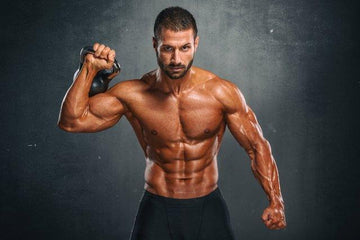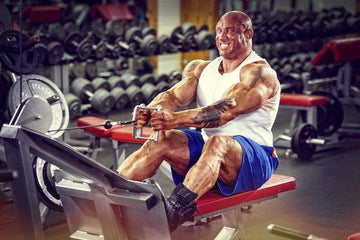

Posing Can Enhance Muscle Growth
Table of Contents
Posing Can Enhance Muscle Growth
by: Robbie Durand
The science of muscle growth has changed dramatically in the last year. No longer can you say that the only way to get bigger is to lift heavy weights. For example, moderate loads (20-30% 1RM) with blood flow restriction increases muscle size similar to that of high load (>70%1RM) training. What this proves is that it is not just the amount of weight you have on the bar that’s going to make muscles grow, there are other factors involved. Additionally, isometric contractions (i.e. squeezing a muscle with no movement) can also increase muscle growth. Since isometric contractions can increase muscle growth, then it makes sense that maybe posing which consists of intense muscle contractions may influence muscle growth.
Posing is a lost art in bodybuilding. Arnold Schwarzenegger used to spend hours of posing, in fact, he started taking ballerina classes to make him a better poser. Many lifters know that posing is extremely fatiguing and often neglected; but actively contracting your muscles can add inches, according to new research.
 Squeeze the Muscle While Lifting Weights Adds Size
Squeeze the Muscle While Lifting Weights Adds Size
Many lifters have heard to squeeze the muscle during workouts, but not many people follow this, as more often lifters just go to the gym and throw the weight around. One study reported positive increases in muscle mass from squeezing the muscle while lifting. Sixteen young men were allocated to training or a control group. The training group conducted a 12-week, three-day-a-week training program that consisted of four-second maximal voluntary contractions of biceps and triceps. The men would spend time simultaneously contracting their biceps and triceps. Muscle strength and thicknesses of biceps and triceps were measured before intervention and after four and 12 weeks. At the end of the study, muscle size also significantly increased in both biceps (+4%) and triceps (+4%) at 12 weeks. This study shows that isometric contractions can increase strength and muscle mass. So when you are in the gym, make sure you squeeze the muscle and contract it while lifting for maximal muscle growth.
“NO LOAD” Resistance Training Results in Increased Muscle Mass
In the latest study published in the Journal of Physiology and Behavior titled, “The acute and chronic effects of “NO LOAD” resistance training” researchers made a shocking discovery. Muscle can grow without weights!! In fact, the study found that those that performed maximal contractions without any weights had the same amount of muscle growth as those subjects’ that lifted weights.
Thirteen participants completed 18 sessions of bicep curling exercise. Each arm was designated to either “NO LOAD” or HIGH LOAD condition (70% one repetition maximum). In the HIGH LOAD condition completed four sets of 8-12 repetitions with 90 seconds of rest between sets at 70% of their 1RM.
For the NO LOAD condition, participants repeatedly contracted as hard as they could through a full range of motion without the use of an external load. The participants completed four sets of 20 repetitions with 30 seconds of rest between sets.
 At the end of the study, it was found that following six weeks of training, the HIGH LOAD condition increased 1RM strength more than the NO LOAD condition. However, upper arm muscle thickness increased in the NO LOAD condition, despite training with no external load. This increase was similar to that of HIGH LOAD training, which is a stimulus known to increase muscle size.
At the end of the study, it was found that following six weeks of training, the HIGH LOAD condition increased 1RM strength more than the NO LOAD condition. However, upper arm muscle thickness increased in the NO LOAD condition, despite training with no external load. This increase was similar to that of HIGH LOAD training, which is a stimulus known to increase muscle size.
The Researchers concluded that:
1.) Contracting muscle through a full range of motion with no external load increases muscle size similar to high load training.
2.) High load training produced larger increases in 1RM strength & muscle endurance compared to contracting with no external load.
3.) Muscle growth can occur independent of the external load provided sufficient tension is produced by the muscle.
Key Points: Posing and contracting muscles thru a full range of motion can increase muscle mass, similar to using heavy weights. Also, when lifting, one can use a lighter weight and contract the muscle during the full range of motion and have similar gains in muscle mass, but not strength. Counts BR, Dankel SJ, Barnett BE, Kim D, Mouser JG, Allen KM, Thiebaud RS, Abe T, Bemben MG, Loenneke JP. Influence of relative blood flow restriction pressure on muscle activation and muscle adaptation. Muscle Nerve. 2016: 53: 438-445.
Esposito F, Ce E, Gobbo M, Veicsteinas A, Orizio C. Surface EMG and mechanomyogram disclose isokinetic training effects on quadriceps muscle in elderly people. Eur J Appl Physiol. 2005: 94: 549-557.
Farup J, de Paoli F, Bjerg K, Riis S, Ringgard S, Vissing K. Blood flow restricted and traditional resistance training performed to fatigue produce equal muscle hypertrophy. Scand J Med Sci Sports. 2015: 25: 754-763.
Mitchell CJ, Churchward-Venne TA, West DW, Burd NA, Breen L, Baker SK, Phillips SM. Resistance exercise load does not determine training-mediated hypertrophic gains in young men. J Appl Physiol. 2012: 113: 71-77.
Ogasawara R, Loenneke JP, Thiebaud RS, Abe T. Low-Load Bench Press Training to Fatigue Results in Muscle Hypertrophy Similar to High-Load Bench Press Training. Int J Clin Med. 2013: 4: 114-121.
Brittany R. Counts, , Samuel L. Buckner, , Scott J. Dankel, , Matthew B. Jessee, , Kevin T. Mattocks, , J. Grant Mouser, , Gilberto C. Laurentino, , Jeremy P. Loenneke, The acute and chronic effects of “NO LOAD” resistance training. Physiology & Behavior, Volume 164, Part A, 1 October 2016, Pages 345–352

















